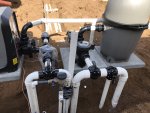Hello,
I am new to this forum and my wife and I just moved into our new home. This is the first time I've ever owned and worked on a pool. Since moving in I've learned a lot and was about to do a lot of my own repairs but I am now stuck right here. I noticed my pump was sucking air and I pinpointed where it was coming from. I feel I am fully capable of doing this repair but my question lies in where would I make the cut and how would I take the pvc pipe out of the pump to replace all those connection pieces? Any help would be great. I've attached a photo of where the pump is sucking air from. Thank you

I am new to this forum and my wife and I just moved into our new home. This is the first time I've ever owned and worked on a pool. Since moving in I've learned a lot and was about to do a lot of my own repairs but I am now stuck right here. I noticed my pump was sucking air and I pinpointed where it was coming from. I feel I am fully capable of doing this repair but my question lies in where would I make the cut and how would I take the pvc pipe out of the pump to replace all those connection pieces? Any help would be great. I've attached a photo of where the pump is sucking air from. Thank you






